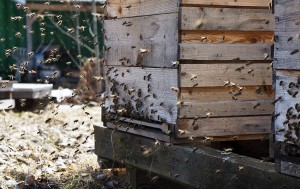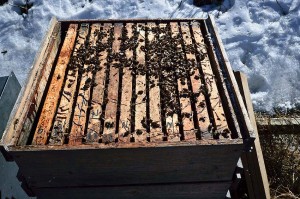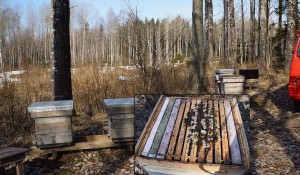Summer of 2012 was not a good one, for bees or for people in Sweden. Long periods of chilly and rainy weather gave smaller clusters going into winter with many times too many of old bees. Winter was long, even if it wasn’t very low temperatures for longer periods of time. But no cleansing flight until late spring. And those bees that start making brood in February anyway and makes a lot they ran out of stores in late March when many beekeepers couldn’t check their bees because snow was still high hindering them access to them. And nights were cold in March, sometimes 20 below freezing.
Very late came the main cleansing flight, day T as in toilet, April 16 with 15 degrees above freezing and sunshine. See picture above.
After telephone calls with beekeepers in different parts of the country conclusion is that winterlosses are high with many beekeepers in many parts of the country, from southernmost part to west to east, and central and north. Some beekeepers have come out of winter with normal losses of 10-20%, while others have lost much much more, even all. Maybe the reported average winterlosses finally will be 20%, maybe somewhat less, maybe more.
In Skane in southermost part beekeepers in monocultural deserts with canola, or beat sugar or similar have lost close to everything, with no bees left in the hives. Never experienced before, with experienced beekeepers. Now, read what Kim Flottum wrote in his editorial in BeeCulture April issue, some posts earlier in this blog.
Almost as high losses have been reported in western Sweden and around Stockholm, but not all hives were without bees. Some have starved, sometimes with food still left, unreachable.
April 1 up till April 11 I went through my apiaries and counted 8 % losses. But some had tiny clusters and some additional % is expected. Some hives looked like this. Remember this is well before cleansing flight with bees still in winter cluster more or less.
This hive above was checked in April 1 in an apiary in which one colony had given up already in autumn, in one now in April 1 i detected a mouse had lived comfortably during the winter in the bottom box (I had forgotten to insert the entrance reducer). I took away the bottom box and the compost there and put the upper two back on the bottom. The bees looked all right but of course a smaller cluster than otherwise.
This apiary was checked April 11. The opened hive was the weakest. These woodbees have made it very well, well away from neonics. All of them fine. As you see I use single walled wooden hives three story shallow boxes with 12 frames each. The upper box usually filled with honey for winter and additional sugar solution to pop them up. In November if the bees have contracted much I take away some outer honey frames in the upper box and give the insulation dummy frames instead. These honey frames are given to the needy in spring or to splits in second half of May or early June.
As I have a program for selecting varroa resistance I let the colonies show when and if they need treatment for Varroa. In this forest apiary I have six colonies. From left to right they got during last season the following treatment of Thymol strips on the queen excluder: 10gr, 10gr, 20gr, 30gr, 0gr, 0gr. The strongest now in April was no 2 and 3. No 4 was the weakest. The two last ones were early splits last year made with brood. If you have nonselected bees for varroa resistance (and if your bees are NOT on small cell size) you should usually need about 50gr of Thymol during a season, if not more (if you have a lot of bees in the neigbourhood, and not enough nourishment and the new chemicals in the fields) , diveded in one spring and one late summer treatment.


